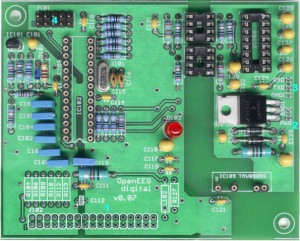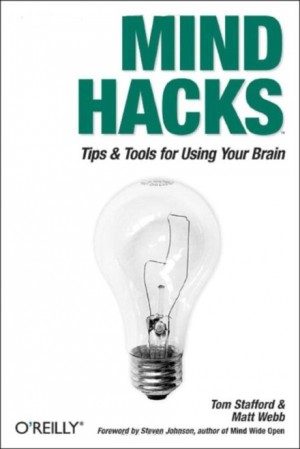Hacking the Mind
One Hundred Mind Hacks
Mind Hacks is a book by Tom Stafford and Matt Webb, and a great accompanying blog, featuring all sorts of tips and tricks on how to figure out more about the workings of your brain. It shows how abstract neuroscientific knowledge about sensors and neurons and different regions of the brain can be recognized in the details of one's own daily behavior.
The chapters in the book list 100 so-called Hacks, each one focusing on one specific behavior of our mind, covering how and what we see, what we pay attention to, how language influences us, how we reason or how we remember. Some of the hacks are well known examples (#23 See How Brightness Differs from Luminance: The Checker Shadow Illusion), some confirm what intuition told us so anyway (#54 Don't Divide Attention Across Locations) and others reveal new little interesting details about the brain (#45 Detect Sound Direction). They come with instructions on how to test out the newly learned knowledge on your own head.
All of them definitely succeed in raising your awareness to the fact that our brains are highly evolved and highly complex, that they are nevertheless easy to be fooled and also very predictable. I have to say i am very curious to see where all of this will lead us to. You Are What You Think (#100) is a powerful idea. Will it be easier to consciously craft our brains, or does ignorance work best?
HACK #6
The 10% Myth is so wrong! Of course we use all of our brain!
It's such an powerful image, but it's just not true. There is no unused resource of your brain! You use all your brain's plasticity to keep learning and functioning across your life span. Nevertheless, there is always space for improvement, yet it's more about how you use your brain and not about how much of it.
HACK #26
We get used to things because our brain finds consistency boring and adjusts to filter it out.
Therefore you can trip out in the real world, after staring intently for a minute at a waterfall or a rotating spiral (#25 The Motion Aftereffect). It's all about the change, nothing in this world seems to rely on absolute values anyway!

OpenEEG
Wanna try and measure your brainwaves? OpenEEG is and open-source hardware project, releasing hardware-kits and circuit-board schematics for building your own low-cost EEG device. http://openeeg.sourceforge.net/doc/
Numbers and Time Intervals
Every 2 milliseconds is the fastest our neurons can fire (and that only counts for neurons in the auditory system). Our eyes make quick shifts of gaze - saccades - up to five times a second. Those movements actually leave us blind, which is the reason behind the stopped clock illusion (#18 When Time Stands Still). Our visual system requires exposure to an image for around 30 milliseconds to report and input to consciousness (else it might still land in subliminal-land). Our auditory system is able to detect periods of silence in sounds of as little as 1 millisecond (#44 Detecting Timing with Your Ears).
Sound = Action!
Vision and Hearing are our most important senses. Light and sound seem omnipresent, yet they tell so different stories!
While Light is around all the time, sound only occurs when things change!
There is light even when nothing happens. Yet for sound we need vibrations, movements, collisions, explosions! Interesting side-fact: Hearing is our first sense - the first we developed in the womb, and the first to return after regaining consciousness.
The World in Us
We are better at making out details in the lower half of our visual field (#34 Detail and the Limits of Attention), because that's where the action usually happens. And we have adapted to always assume a source of light located above us, which influences how we interpret conflicting shadow and depth illusions (#20 Fool Yourself into Seeing 3D).
HACK #30
And i leave you with the Rotating Snake Illusion!
It is based on the Peripheral Drift Illusion and all sorts of awesome! Also, take a look at this image.

